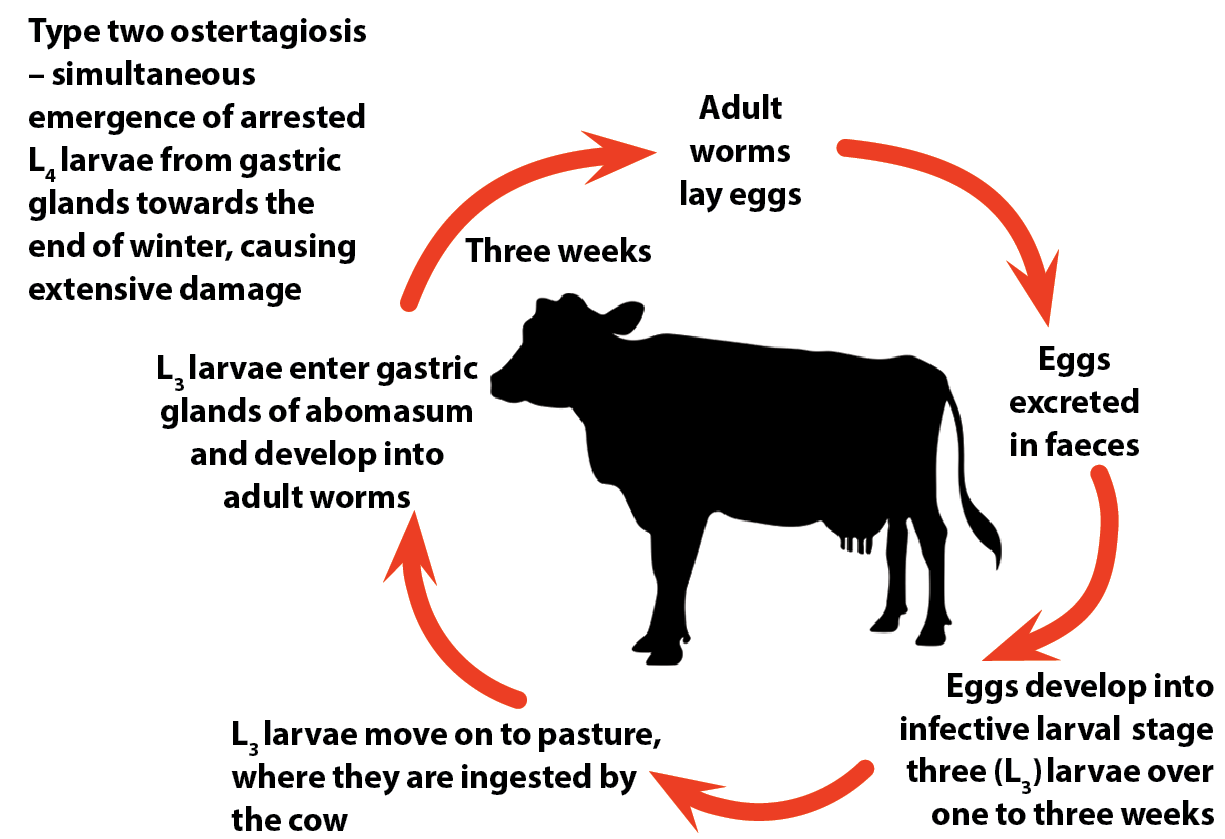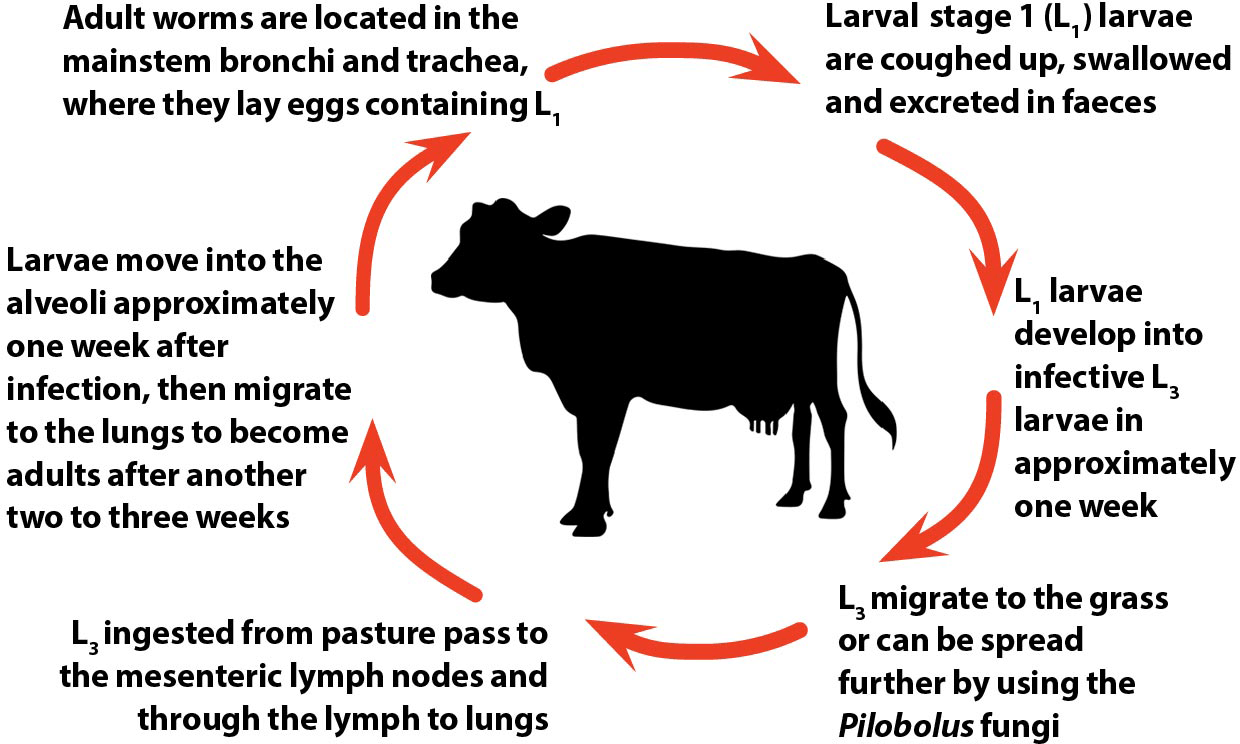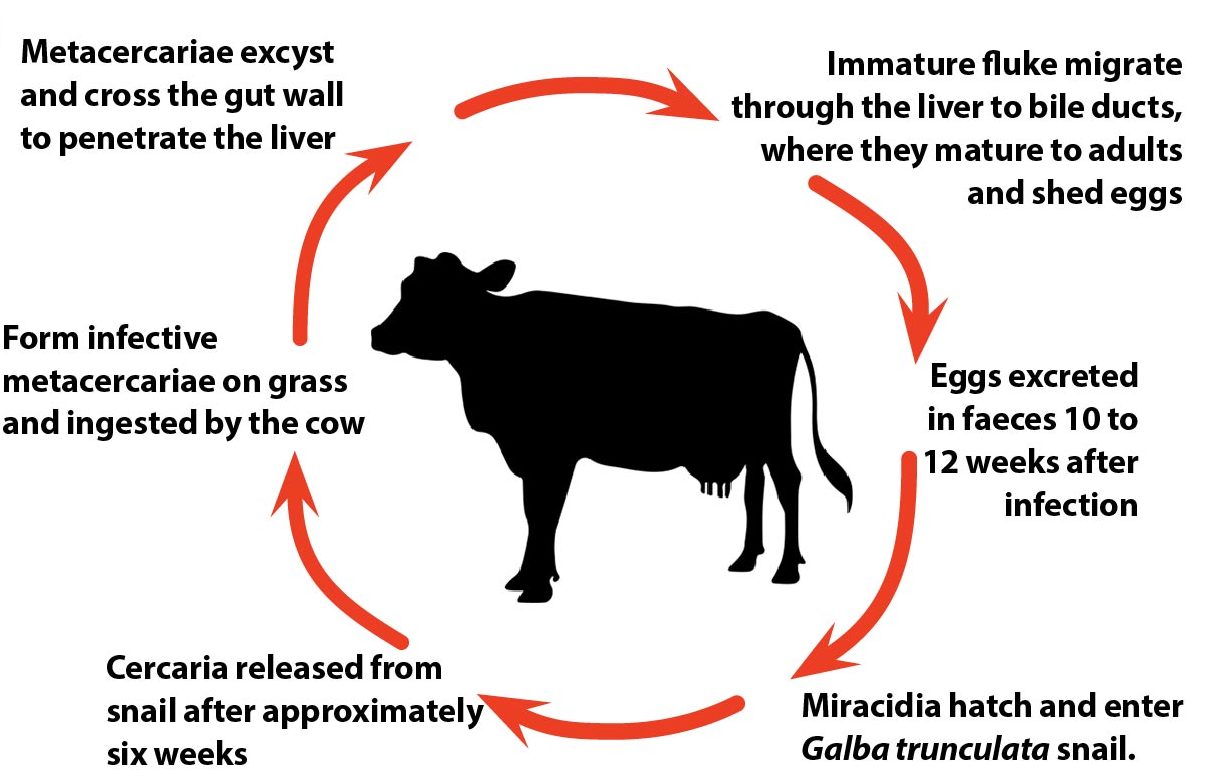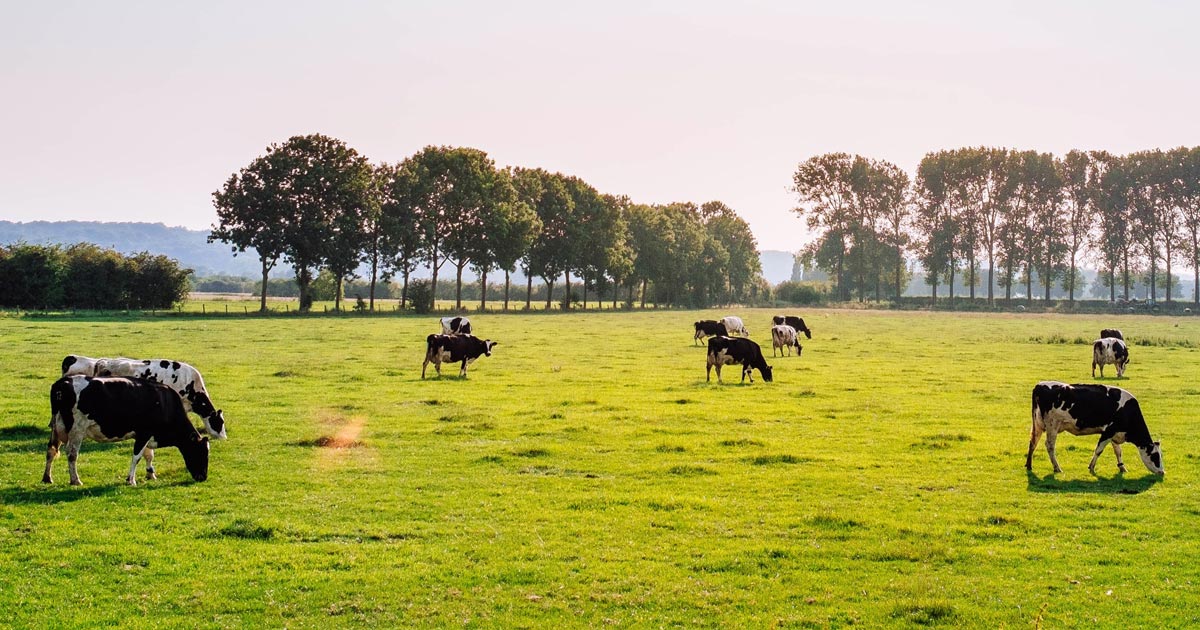24 Sept 2018
Adult cattle worms: overview of parasites and treatment options
Sophie Mahendran looks at important nematodes that affect dairy cows, their life cycles and worming protocols.

The conundrum of adult cattle worming is a complex issue, with respect to the responsible use of anthelmintics versus the need to ensure optimum efficiency for milk production.
This article will give an overview of the different worms that affect cattle, and arguments for and against the use of anthelmintics in both dry and lactating cows.
High levels of polyparasitism have been noted in cull cow studies from dairy cows in Ireland, which demonstrated up to a 57% prevalence of cows with apparent Ostertagia ostertagi infections, 65% prevalence of fluke in livers, and 14% prevalence of lungworm larvae in faeces (Murphy et al, 2006). This clearly indicates the need to consider adult dairy cows in preventive worming protocols.
It is known that after the first grazing season cattle develop either partial or total immunity to gastrointestinal nematodes, with the exception being immunity to lungworms, to which they only produce a short duration of immunity and, therefore, require seasonal antigenic stimulation. This means although clinical disease is uncommon in adult cattle, they often have a significant burden of parasites that have the potential to impact on milk production and fertility.
Important nematodes and their life cycles
The common nematode (roundworm) that affects cattle is O ostertagi (Figure 1), but others include Cooperia oncophora and Trichostrongylus axei.

The level of pasture contamination with O ostertagi appears to be increasing, with one study indicating a threefold increase in pasture burden over a 30-year period (Fox et al, 2007). Diagnosis of O ostertagi can be made using commercially available antibody tests.
The milk O ostertagi test is used on bulk tank milk, with the level of antibodies indicating the relative exposure of the cattle and, therefore, providing an estimate of the potential milk lost. However, the antibody test is less useful on individual cows where the interpretation is unable to give you an accurate indicator of active infection or the size of the worm burden (Charlier et al, 2009).
The lungworm Dictyocaulus viviparus (Figure 2) is the cause of parasitic bronchitis. The risk of lungworm outbreaks in adult cattle appears to be increasing, with the main risk being the buying in of cattle that are shedding larval stage one (L1) larvae into a previously negative herd. Diagnosis can be made via faecal Baermann flotation test to detect L1 larvae excreted in the faeces.

The most important trematode affecting cattle is the liver fluke Fasciola hepatica (Figure 3), spread by the mud snail Galba trunculata, which inhabits wet ground in the summer. Cattle develop a chronic form of the infestation, with high burdens causing reduced production, weight loss and, occasionally, anaemia. Having liver fluke is also known to make cattle more susceptible to developing other diseases, such as Salmonella dublin and Clostridium novyi.

Reports from the abattoir can give an indication of the level of liver damage and presence of fluke. This valuable information can build a picture of whether fluke is an issue on a farm and the effectiveness of any control programmes.
Other methods of diagnosing infection include faecal egg counts, antibody ELISA detection in serum or bulk tank milk, and the faecal coproantigen ELISA.
Pros and cons of worming
The impact of worming adult cattle is dependent on the worm burden they are exposed to and carrying.
On farms with high levels of infections, worming of cattle is estimated to benefit farms by an estimated £15 to £63 due to the improvements in milk yield and fertility.
The increased milk yield has been reported in many studies, with varying figures established. Higher estimates include a milk yield increase of 2.35kg/day in grazing cattle treated with eprinomectin (Forbes et al, 2004). Another study indicated a 0.85kg/day increase in milk by six weeks post-treatment, with herds that had more than 22% of the herd having a positive faecal egg count experiencing the biggest benefit (Ravinet et al, 2014).
However, other reviews have cited a much smaller increase in milk yield of only 0.35kg/day (Sanchez et al, 2004). This wide range in reported benefits on milk yield is probably due to the plethora of approaches and trial designs used in these studies, with confounders including lactation number and stage, and the length of follow-up time (Charlier et al, 2009).
Regardless of the actual increase in milk production, it is known higher-producing animals are more susceptible to gastrointestinal nematodes, potentially resulting in higher treatment responses. Effects of parasitism on weight gain can also be an important consideration.
The biggest impact on growth is during the first grazing season, but the effects of this check remain until the end of the second grazing season and have an impact on the heifers’ first lactation yield (Larsson, 2006).
The final potential benefit of worming is the marginal improvement in fertility that may be achieved. The evidence regarding fertility is the most limited, with potential reductions in calving-to-conception interval and improvements in conception rates noted.
Although the potential benefits to production have been described, conflicting arguments as to the true increase in efficiency that can be achieved by whole-herd worming, due to the burden variation, still exist – the majority of cows will have relatively low worm burdens due to their resistance status, while a smaller proportion will have high parasite burden impacting milk production (Ravinet et al, 2014).
Additionally, the increase in selection pressure caused by the blanket use of anthelmintics could result in the emergence and spread of anthelmintic resistance within worm populations, especially if persistent activity products are used – such as macrocyclic lactones, which have activity for three to six weeks following administration.
When to worm
If worming is carried out, the decision on when to worm must be carefully considered, with the target’s life cycle in mind, and is dependent on whether the herd is block or year-round calving.
The best response in block calving herds has been shown to be worming the whole herd at calving, although it was noted use of more selective treatment strategies could also be economically sustainable in herds with low levels of infection (Charlier et al, 2012).
Worming cattle at calving is often cited to improve milk yields, although this effect may be exaggerated in early lactation due to improved milk yields being more significant in early lactation. This early treatment also allows for the effect on fertility to be appraised, as this can only be noted if treatment is given before the cow is back in calf (Charlier et al, 2012).
In addition, worming of all cattle at the same time is regarded as easier by many farmers, saving time on labour and ensuring minimal wastage of the products.
In year-round calving herds, the optimal time(s) to treat can depend on the worm burdens the cattle are exposed to, so strategic worming at high-risk times of the year can be used. It may be beneficial to worm in the spring, a few weeks after the cattle start grazing. This strategy allows the cattle to harvest and ingest the overwintering larvae off the pasture before they contribute to a new generation of worms. This strategic approach will lessen the exposure the cattle will have later on in the grazing season (Craig, 2018).
Alternatively, if the exposure to nematodes other than O ostertagi is low, it may also be useful to just use anthelmintics in the autumn to reduce O ostertagi hypobiosis that could result in ostertagiosis type two in the spring as the larvae emerge from the gastric glands, potentially causing a large amount of damage to the abomasal wall.
The decision on which wormer to use is usually dictated by the milk withdrawal period for lactating cows. For nematodes, products with the active compound eprinomectin have a zero milk withhold, making it the only practical solution for worming lactating animals. In the UK, the products available with this active are both pour-on solutions, which is the easiest method.
As with all wormers, they must be applied at the correct dose for the weight of the animal and should be applied to a dry clean animal, when it is not expected to rain within two hours of application.

Making worming sustainable
After the decision is made to treat adult cattle with anthelmintics, a further consideration to try to reduce the development of resistance is to leave a subset of the population untreated.
This idea of a “refugia” population of untreated worms is common practice in sheep flocks and enables any resistant worms excreted on to pasture to be diluted by non-resistant worms. Selection of cows not to treat can be based on either identification of cattle with a low faecal egg count or, more subjectively, by selecting cattle in good body condition score and with fewer metabolic challenges, such as those towards the end of lactation.
The other consideration is the requirement to treat cattle for liver fluke. The risk period for active migration and development of adult fluke is in the winter period.
However, the biggest issue is a product for lactating cows that has a zero-hour milk withhold is not available. Two products exist that can be given at the start of the dry period, and one product that has a 72-hour milk withhold, which could be given any time during the dry period. This means only dry period dosing of dairy cattle can be conducted if milk is not to be disposed of. The implication of this is many animals may not receive a flukicide treatment at the ideal part of the life cycle, but on farms heavily infected with fluke, no alternative may be available.
Conclusion
Understanding the presence and potential effects of adult cattle worms can be challenging, especially as the epidemiology can change substantially between different farms due to geography and environmental factors. Identification of high burdens and appropriate use of anthelmintics may improve production in lactating cattle, but prudent and responsible use must also be remembered to safeguard the efficacy of our anthelmintic products.
